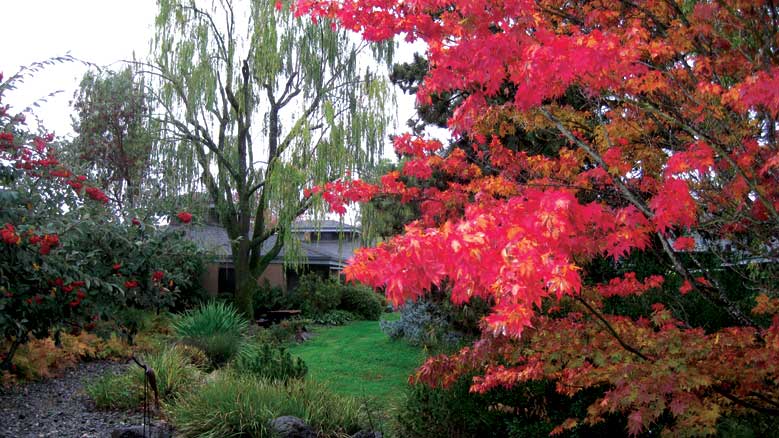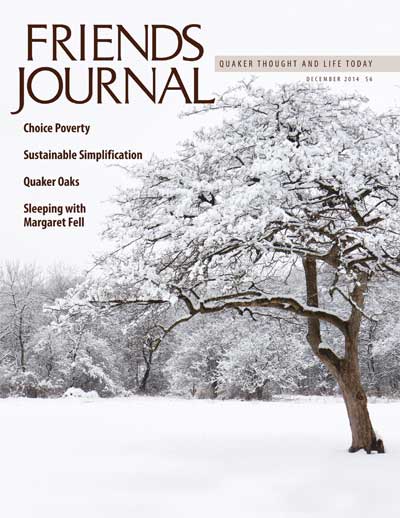 My sweet home for the past ten years has been a garden cottage at Friends House, a small retirement community in Santa Rosa just an hour north of San Francisco, Calif. At birth I became a member of Haverford (Pa.) Meeting; in grade school I belonged to Baltimore (Md.) Meeting. Later I joined Third Haven Meeting in Easton, Md., and there, in the historic 1684 meetinghouse, married my husband, Bryant, in 1954. My parents are buried in Third Haven cemetery, and Bryant’s memorial plaque was recently mounted on a nearby brick wall; he passed away in 2011.
My sweet home for the past ten years has been a garden cottage at Friends House, a small retirement community in Santa Rosa just an hour north of San Francisco, Calif. At birth I became a member of Haverford (Pa.) Meeting; in grade school I belonged to Baltimore (Md.) Meeting. Later I joined Third Haven Meeting in Easton, Md., and there, in the historic 1684 meetinghouse, married my husband, Bryant, in 1954. My parents are buried in Third Haven cemetery, and Bryant’s memorial plaque was recently mounted on a nearby brick wall; he passed away in 2011.
I am former clerk of the Apartment Residents’ Association at Friends House and former five-year member of the Friends Association of Services for the Elderly (FASE) Board of Directors. Since early 2008, my other principal volunteering job has been as the resident Program Committee’s person who seeks outside musicians to perform for us residents for free; usually I schedule one Sunday afternoon concert per month. This past spring, I was involved in the planning of Friends House’s thirtieth anniversary, and I wrote this piece as an anatomy of our celebration.
First there was the idea. Next was the empty field with one outstanding valley oak near a creek. Examining the field was a bunch of Quakers from the San Francisco Bay Area. The field that day was muddy and the sky overcast. The group observed vernal pools in the oak’s vicinity. The idea that the group was savoring was buying this land in Rincon Valley on the northeast edge of Santa Rosa. They noted the terrain’s relative flatness and the beauty of the rounded hills above the valley. Pacing about, they envisioned constructing cottages, common gathering areas, and service facilities as a home for aging Quakers and like-minded friends.
Prominent among the early visionaries, planners, and fundraisers for the future Friends House were Elizabeth Boardman, Margret Bowman, Edwin “Red” Stephenson, Dorothy Marshall, Bob Schutz, Mike Ingerman, and architects who espoused a philosophy that certain architectural features could consciously enhance a spirit of community. The earliest residents moved into the independent-living garden cottages of our new campus in March of 1984.
Thirty years have passed. Another small group was recently meeting on campus to plan our community’s celebration that would express thankfulness and humble pride and would emphasize our strengths and specialness. We planners consisted of one manager—experienced at throwing large parties!—and five apartment residents. Quickly our committee settled on a statement of the celebration’s tripartite aim: “to honor our past, celebrate our present, and envision our future”—and we would focus on the present. Next, it took no time to articulate desires for music on all three days and for fine food throughout the April 26 weekend of fun.
The remainder of the planning, however, was scarcely easy. The committee expected to invite scores of people to visit Friends House for the first time, as well as many who might wish to learn more about what living here is like, and still others who already treasure this place. We had to deliberate at length over what types of events would best show off the activities and attitudes we value! It was hard to decide how to present the messages of our varying activities to outsiders. We debated what proportion of residents-to-special-guests we should showcase. We pored over positioning and duration of the events to be scheduled. We even wrangled over devising a 20-question “walkabout” game to stimulate guests to explore our pretty campus. In the end—naturally—we adopted each other’s good ideas, acquiesced to what had to be accepted, and moved into the actual weekend with high spirits.
The celebration included a brief time-niche for talks on past Friends House achievements and future plans. Campus tours were offered regularly. Our kitchen served delicious food at various receptions and a luncheon at long tables on the Green. For music, we felt totally honored that, one afternoon, prominent musicians Corrick and Norma Brown performed four-handed on our 1924 Mason & Hamlin grand piano; one evening, the inimitable Occidental Community Choir sang; and on Sunday morning, hymn-singing occurred as usual.
Current Friends House interests and activities were featured including residents who read prose passages they had authored; an energetic Fitness Center routine; a display of handiwork creations; and a show of our art. The on-campus Friends of the Homeless group displayed photographs of its efforts over the years. In other performances, resident and outside poets read, and our Peace and Justice group did its usual weekly thing by showing and discussing a Bill Moyers interview video. Visitors strolled our halls and common rooms examining exhibits that highlighted our volunteering at many off-campus organizations. A seniors’ memoir-writing class that for 29 years has held its meetings at Friends House was invited to be present. Happily, at an appropriate point, the party crowd joined together to demolish a great thirtieth birthday cake and listen to two residents sing silly songs.
Silent worship in the library on Sunday concluded the celebratory weekend. During this period of meditation, Margaret Sorrel (member of our board of directors and daughter of two honored residents) stood to speak, as happens in Friends meeting for worship. Voicing the joy we had all been feeling, Margaret quoted a youngish physician who had been visiting Friends House for the first time. He had said to her, “I’ve never seen so many older people so happy. I want to retire here myself, and right now I’d like my aunt to move here.” Upon hearing these sentiments, we emerged to repeat them, with wonderment and gladness, to others who had not heard.
A note from Mira Wonderwheel, development director of Friends House: Sadly, that outstanding valley oak near the creek is no longer standing, but fortunately, the roots of the Friends House community (that shared many a meal under that beautiful tree) and the values of that original group of Quaker visionaries still run deep. Now, there is a new group of visionaries planning for the next 30 years of Friends House.







Comments on Friendsjournal.org may be used in the Forum of the print magazine and may be edited for length and clarity.